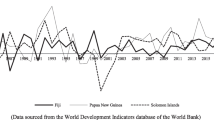Abstract
Additionality. in the sense that debt relief should supplement, not replace, the flow of development aid is a key concept underlying the HIPC Initiative. But assessing the additionality of HIPC debt relief is extremely difficult, if not outright impossible. Some writers (e.g. Birdsall and Williamson, 2002), expect only modest additionality from bilateral donors while they doubt that debt relief from the World Bank can be additional. This leaves the IMF as the main contributor of additional resources.
I am grateful to Carl-Johan Dalgaard for numerous discussions that turned an idea at large into the present study, to Peter Hjertholm for his encyclopaedic knowledge about external debt in developing countries and to Jens Kovsted and John Rand for their sharp comments.
Access this chapter
Tax calculation will be finalised at checkout
Purchases are for personal use only
Preview
Unable to display preview. Download preview PDF.
Similar content being viewed by others
References
Arellano, M. and O. Bover (1995). ‘Another Look at the Instrumental Variables Estimation of Error-Components Models’, Journal of Econometrics. 68: 29–51.
Atkinson, A. C. (1970). ‘A Method for Discriminating between Models’, Journal of the Royal Statistical Society. Series B, 32: 323–53.
Birdsall, N. and J. Williamson (2002). ‘Delivering on Debt Relief: From IMF Gold to a New Aid Architecture’, Washington, DC: Center for Global Development and Institute for International Economics.
Burnside, C. and D. Dollar (2000). ‘Aid, Policies, and Growth’, American Economic Review, 90: 847–68.
Chang, C. C., E. Fernandez-Arias and L. Servén (1998). ‘Measuring Aid Flows: A New Approach’, Policy Research Working Paper 2050, Washington, DC: World Bank.
Chong, A. and C. Calderon (2000). ‘Causality and Feedback Between Institutional Measures and Economic Growth’, Economics and Politics. 12: 69–81.
Claessens, S., E. Detragiache, R. Kanbur and P. Wickham (1997). ‘Analytical Aspects of the Debt Problems of Heavily Indebted Poor Countries’, in Z. Iqbal and R. Kanbur (eds), External Finance for Low-Income Countries. Washington, DC: International Monetary Fund, 21–48.
Cohen, D. (1993). ‘Low Investment and Large LDC Debt in the 1980s’, American Economic Review. 83: 437–49.
Dalgaard, C.-J. and H. Hansen (2001). ‘On Aid, Growth and Good Policies’, Journal of Development Studies. 37: 17–41.
Dijkstra, G. and N. Hermes (2001). ‘The Uncertainty of Debt Service Payments and Economic Growth of HIPCs: Is There a Case for Debt Relief?’, WIDER Discussion Paper DP2001/122, Helsinki: UNU-WIDER.
Easterly, W. R. (1999). ‘How Did Highly Indebted Poor Countries Become Highly Indebted? Reviewing Two Decades of Debt Relief’, Development Research Group, Washington, DC: World Bank.
Easterly, W. R. (2000). ‘When Is Fiscal Adjustment an Illusion?’, Economic Policy, 28: 57–86.
Easterly, W. R. (2001). ‘Growth Implosions and Debt Explosions: Do Growth Slowdowns Cause Public Debt Crises?’, Contributions to Macroeconomics. 1: Article 1.
Gourieroux, C. and A. Monfort (1994). ‘Testing Non-Nested Hypotheses’, in R. F. Engle and D. L. McFadden (eds), Handbook of Econometrics, IV, Amsterdam Elsevier Science, 2583–37.
Greene, J. and D. Villanueva (1991). ‘Private Investment in Developing Countries’, IMF Staff Papers. 38: 33–58.
Hansen, H. and F. Tarp (2000). ‘Aid Effectiveness Disputed’, Journal of International Development. 12: 375–98.
Hansen, H. and F. Tarp (2001). ‘Aid and Growth Regressions’, Journal of Development Economics. 64: 547–70.
Hayashi, F. (2000). Econometrics. Princeton: Princeton University Press.
IMF (International Monetary Fund) and IDA (International Development Association) (2002). ‘Heavily Indebted Poor Countries (HIPC) Initiative: Status of Implementation’, available at: http://www.imf.org/external/np/hipc/2002/status/041202.htm.
Kanbur, R. (2000). ‘Aid, Conditionality and Debt in Africa’, in F. Tarp (ed.), Foreign Aid and Development: Lessons Learnt and Directions for the Future, London and New York: Routledge, 409–22.
Knack, S. and P. Keefer (1995). ‘Institutions and Economic Performance: Cross-Country Tests Using Alternative Institutional Measures’, Economics and Politics, 7: 207–27.
Krugman, P. (1988). ‘Financing vs. Forgiving a Debt Overhang: Some Analytical Notes’, Journal of Development Economics. 29: 253–68.
Lensink, R. and O. Morrissey (2000). ‘Aid Instability as a Measure of Uncertainty and the Positive Impact of Aid on Growth’, Journal of Development Studies. 36: 31–49.
Levine, R. and D. Renelt (1992). ‘A Sensitivity Analysis of Cross-Country Growth Regressions’, American Economic Review, 82: 942–63.
Oshikoya, T. W. (1994). ‘Macroeconomic Determinants of Domestic Private Investment in Africa: An Empirical Analysis’, Economic Development and Cultural Change. 42: 573–96.
Papanek, G. F. (1972). ‘The Effect of Aid and Other Resource Transfers on Savings and Growth in Less Developed Countries’, Economic Journal, 82: 934–50.
Renard, R. and D. Cassimon (2001). ‘On the Pitfalls of Measuring Aid’, WIDER Discussion Paper DP2001/69, Helsinki: UNU-WIDER.
Sachs, J. D. (1989). ‘The Debt Overhang of Developing Countries’, in J. B. de Macedo and R. Findlay (eds), Debt, Growth and Stabilization: Essay in Memory of Carlos F. Diaz Alejandro, Oxford: Basil Blackwell for UNU-WIDER.
Sachs, J. D., K. Botchwey, M. Cuchra and S. Sievers (1999). ‘Implementing Debt Relief for the HIPCs’, Center for International Development Working Paper, Cambridge, MA: Harvard University.
Sachs, J. D. and A. M. Warner (1995). ‘Economic Reform and the Process of Global Integration’, Brooking Papers on Economic Activity. 1: 1–118.
Savides, A. (1992). ‘Investment Slowdown in Developing Countries during the 1980s: Debt Overhang or Foreign Capital Inflows?’, Kyklos. 45: 363–78.
Serven, L. and A. Solimano (1993). ‘Debt Crisis, Adjustment Policies and Capital Formation in Developing Countries: Where Do We Stand?’, World Development, 21: 127–40.
UNCTAD (United Nations Conference on Trade and Development) (2000). The Least Developed Countries 2000 Report. New York and Geneva: UNCTAD.
Warner, A. M. (1992). ‘Did the Debt Crisis Cause the Investment Crisis?’, Quarterly Journal of Economics. 107: 1161–86.
World Bank (1998). Assessing Aid, What Works, What Doesn’t, and Why. World Bank Policy Research Report, Oxford: Oxford University Press.
Editor information
Editors and Affiliations
Copyright information
© 2004 The United Nations University
About this chapter
Cite this chapter
Hansen, H. (2004). The Impact of External Aid and External Debt on Growth and Investment. In: Addison, T., Hansen, H., Tarp, F. (eds) Debt Relief for Poor Countries. Studies in Development Economics and Policy. Palgrave Macmillan, London. https://doi.org/10.1057/9780230522329_7
Download citation
DOI: https://doi.org/10.1057/9780230522329_7
Publisher Name: Palgrave Macmillan, London
Print ISBN: 978-1-4039-3495-6
Online ISBN: 978-0-230-52232-9
eBook Packages: Palgrave Economics & Finance CollectionEconomics and Finance (R0)




